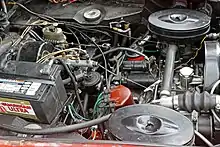Lancia Flat-4 engine
The Lancia Flat-4 engine is an aluminum, pushrod flat-four (boxer) engine made by Lancia for the Flavia from 1960 through 1984. Though it was a pushrod engine, it was advanced for the time.[1] The pushrod version of the Lancia boxer was only ever used in the Flavia, and its derivatives including the Lancia 2000. In 1976, a new overhead cam engine based on a similar layout was designed and brought into production in 2 and 2.5-litre displacements for the Gamma.
| Flat-4 engine | |
|---|---|
_engine_(26097832230).jpg.webp) Boxer engine installed in a Lancia Flavia | |
| Overview | |
| Production | 1960-1984 |
| Layout | |
| Configuration | Naturally aspirated Flat-4 |
| Displacement |
|
| Cylinder bore |
|
| Piston stroke |
|
| Block material | Light alloy |
| Head material | Aluminum |
| Valvetrain | Pushrod or Overhead camshaft |
| Combustion | |
| Fuel system | |
| Fuel type | Petrol |
| Cooling system | Water-cooled |
| Output | |
| Power output | 92–140 bhp (69–104 kW; 93–142 PS) |
| Torque output | 172–208 N⋅m (127–153 lb⋅ft) |
| Chronology | |
| Predecessor | Lancia V4 engine |
Pushrod

1500
The original version was the 1.5 L; 91.5 cu in (1,500 cc) introduced in 1960; it used an 82 mm × 71 mm (3.23 in × 2.80 in) bore and stroke. It was revised on 1963 with a smaller 80 mm (3.15 in) bore and a longer 74 mm (2.91 in) stroke, thus displacing 1.5 L; 90.8 cu in (1,488 cc). A final version was introduced in 1967 with an even longer 80 mm (3.15 in) stroke coupled with a 77 mm (3.03 in) bore, giving a displacement of 1.5 L; 90.9 cu in (1,490 cc). Production ceased in 1970.
1800
The first 1800 was a 1.7 L; 105.4 cu in (1,727 cc) introduced in 1962. It used an 88 mm × 71 mm (3.46 in × 2.80 in) bore and stroke. One year later it was replaced by a true 1.8 L; 109.8 cu in (1,800 cc) engine thanks to a longer 74 mm (2.91 in) stroke. In 1967 appeared the 1.8 L; 110.8 cu in (1,816 cc) version using an 85 mm × 80 mm (3.35 in × 3.15 in) bore and stroke.
2000
The 2.0 L; 121.5 cu in (1,991 cc) 2000 version was the ultimate Flavia engine. Bore and stroke was 89 mm × 80 mm (3.50 in × 3.15 in) for a good oversquare ratio. In 1971, the 2.0 L produced 115 bhp (86 kW; 117 PS),[2] and in the HF Coupé in 1972 it produced 125 bhp (93 kW; 127 PS). This engine was produced from 1968 through 1974.
OHC
Lancia developed the large light-alloy overhead camshaft 2.0-litre and 2.5-litre flat-4 engines specifically for the Lancia Gamma, rather than using Fiat derived engines as used in the Beta and Montecarlo and were in production between 1976 and 1984.
2000
Replacing the 2.0 L pushrod engine used in the Flavia, the new 2.0 L; 122.0 cu in (1,999 cc) OHC engine produced 120 bhp (89 kW; 122 PS) at 5500 rpm[3] and 172 N⋅m (127 lb⋅ft) of torque at 3500 rpm.
2500
The 2.5 L; 151.6 cu in (2,484 cc) engine was initially available with twin-choke Weber carburetors, but in the last few years of production it was equipped with fuel injection. In both forms, it produced 140 bhp (104 kW; 142 PS) at 5400 rpm and 208 N⋅m (153 lb⋅ft) torque at 3000 rpm.[4]
References
| Wikimedia Commons has media related to Lancia Flat-4 engine. |
- Koch, Jeff (April 2008). "Lancia Flavia 1.8 Coupe vs. Alfa GTV 1750". Hemmings Motor News. American City Business Journals. Retrieved 28 December 2013.
Lancia's four has its cylinders horizontally-opposed, à la Porsche (or VW Beetle if you're uncharitable)--except it's water-cooled, hanging out over the nose, and driving the front wheels. Power, even at 92 bhp (69 kW; 93 PS), was far beyond VW's modest output in those days, even allowing for the displacement discrepancy.
- Daily Mail Motor Show Review 1971, page 27
- Daily Express Guide to World Cars 1980, page 37
- Car Catalogue International 1983, page 53